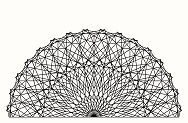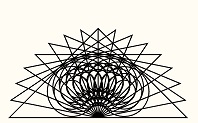


 |
 |
 |
The Cambrian Explosion Of Life October 19, 2023 Plant and animal life began during the Cambrian explosion of life 539 million years ago. Before then, cyanobacteria were evolving photosynthesis; and vibrio type bacteria were exploiting the cyanobacteria. Oceans contained simple forms including sponge types and jellyfish. Fungi are presumed to run back more than a billion years. Scientists don't know why diversification of life-forms exploded 539 mya. The physiology leaves no question about major events. But physiology begins with microbial physiology; and it became more difficult to study, as science got complex, resulting in physiologists becoming molecular biologists, which isn't exactly physiology. The definition of physiology is the integration of biochemical processes. To study the integration requires studying more than one process at the same time, which is quite demanding. But what really created an obstacle is that to study the physiology of bacteria and yeasts requires timed measurements for about three days, because constantly changing physiology cannot be referenced to a single point and timed charts are needed. At universities, timed measurements cannot be made every eight hours or less for three days. So molecules are studied instead of integrated processes; and that leaves disconnected pieces of information where the links have to be guessed rather than measured. Usually, a good guess will be correct, but it leaves the overviews unstudied, particularly since scientists need to study by looking through a straw due to increasing technical details and distracting demands upon their time. So I study the surrounding realities and put the pieces together. It takes a lot of time and the freedom to do so. As knowledge builds upon knowledge, the characteristics of evolution physiology fall into place. Before 539 mya, evolution was being held up by several factors. There was a shortage of minerals in the oceans, because they precipitated out early on. There is always an excess of calcium; and it has low solubility in water. As it precipitates out, it takes other minerals with it. Another problem is that there was no soil on the surface of the Earth, as shale replaced soil. Shale is a soft rock. Some of it "dissolved" into the oceans and precipitated into a gumbo sediment. That type of gumbo covers the western half of South Dakota, while the eastern half is covered with normal clay. The Missouri River runs between them. The gumbo has spots of selenium in it, which is toxic to cattle. Plant roots pick it up, since roots are not selective and will absorb anything that is water soluble. Below the surface of the gumbo, about a hundred feet, are manganese nodules. They cover the river bluffs, as the gumbo washes away and leaves them exposed. So how did all of those problems get solved 539 mya? What problems? All the scientists see is a phylogenetic radiation occurring. It takes evolution physiology to evaluate the complexities that shaped the evolution. The minerals were restored in the oceans, and the Earth's surface was covered with about fifteen inches of clay, due to a planet exploding where the asteroid belt is between Mars and Jupiter. Scientists have known for three hundred years that a planet exploding created the asteroid belt. But a few years ago, as frauds overwhelmed science along with the social structures, they reversed a lot of scientific knowledge. So they said there was no planet that exploded and the asteroid belt was created by the gravity of Jupiter, as if the gravity of an orbiting planet could create the orbit of asteroids fifteen million miles away and cause them to orbit the sun. In other words, there wasn't any more credibility in their science frauds than in their claim that an election was stolen from Trump. Incompetent power mongers need fraud; and they replace credibility with their ability to impose in a terrorist manner. There was another requirement for animal life besides minerals in the oceans. They needed a source of energy as ATP to be produced in a rapid and efficient manner. Modern respiration was created at about that time, which solved that problem. So animal physiology is oriented around the need for ATP production, while plants are relied upon for complex nutrients including vitamins and protein. Modern respiration evolved in the bacterium, Pseudomonas fluorescens, as explained elsewhere, about 600-700 mya. P. fluorescens evolved from vibrio type bacteria which were exploiting the cyanobacteria. Cyanobacteria evolved the porphyrin ring over about a billion years, which made photosynthesis and modern respiration highly efficient. Biochemists had everything about modern respiration worked out, but they could not determine the function of the porphyrin ring. It made ATP production highly efficient, as explained elsewhere. But as always, several year ago, biophysicists were turned loose on the subject like a pack of wolves chasing a rabbit and reversed everything that was previously known about modern respiration. Most basically, they used kinetic energy to transform into chemical energy, which is always an impossibility. Kinetic energy can never transform into chemical energy, because kinetic energy is in the motion of nuclei, while chemical energy is in the motion of electrons. Modern respiration was available when animal evolution began 539 mya. Recent evidence indicates that the first animals evolved 555 mya as a tiny bilateral, burrowing organism called Ikaria wariootia. Plants could not evolve on the surface of the Earth before 539 mya, because shale and rocks covered everything. Geologists claim soil was created from plant roots excreting acids breaking down rocks. They should have flunked out in basket weaving. When acids dissolve something, ions are the products; and they would have washed into the oceans instead of creating a semisolid on the surface, not to mention that plants can't grow on rocks to create soil. There is no chemically identifiable difference between shale and clay. Why the texture is different is unknown. The difference was either due to clay forming on the planet that exploded, or the fine particles of shale reformed their texture into clay by precipitating in the Earth's atmosphere. It can be known that clay did not form with planet Earth, because the surface would not have been uniformly covered, unless the clay formed long after everything else. For a long time, the surface of the Earth was molten rocks with volcanic activity. That doesn't leave a thin layer of clay on the surface. Sometimes, some of the soil on the Earth's surface is attributed to volcanic activity. Volcanoes disappeared until 300 mya, as tectonic plates formed and prevented volcanoes. But as the tectonic plates got thick, they slid under and over each other creating volcanoes, which began 300 million years ago. The evidence is in carbon dioxide being restored in the atmosphere at that time, as explained elsewhere. With clay on the surface, the cyanobacteria could evolve into vascular plants. Since the cyanobacteria evolved photosynthesis and the vascular plants, the older terminology of referring to them as blue-green algae seems more appropriate than cyanobacteria. They are still around thriving in polluted water. If they are neither bacteria nor algae, taxonomists have the age-old problem of figuring out what they should be called.
|
|
|||||||||||||||||
 |
 |
 | ||
 |
 |
 |
||